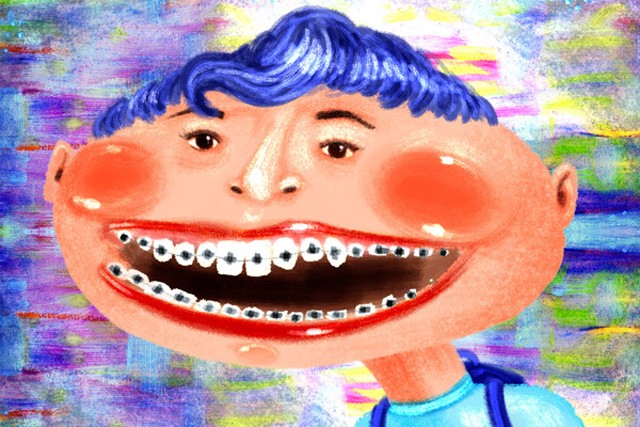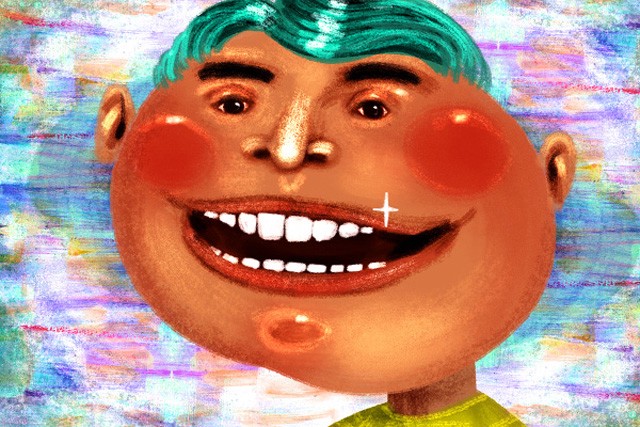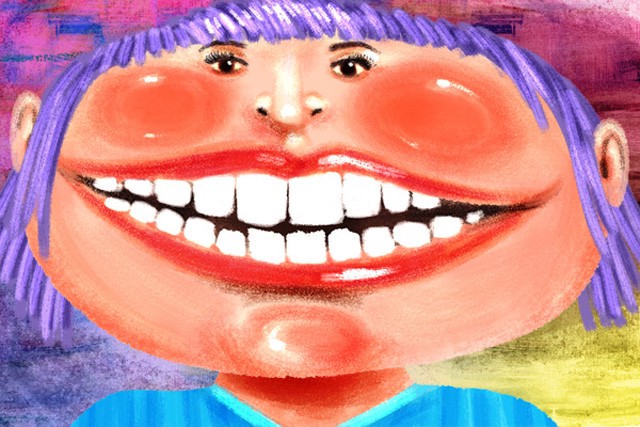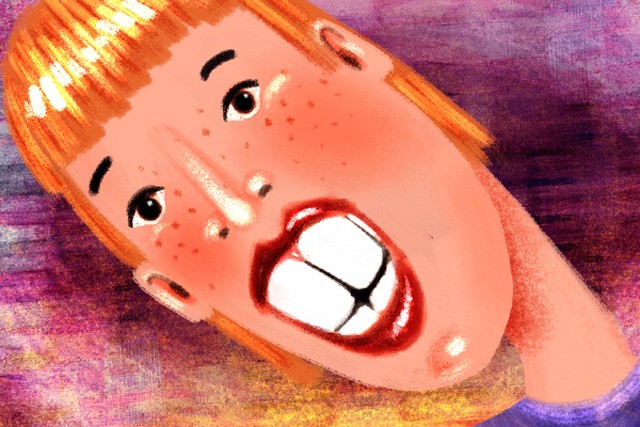The Truth About Your Smile
by Molly Beauchemin

I had braces for seven years of my life — a clumsy mix of palate expanders, headgear, and invasive lip-bumpers that bulked my skinny face at a time when I was already awkward enough without them. I was one of those middle-schoolers whose parents forced orthodontics on them when they were too young to realize what a great investment it was in their future. Instead, I adopted a coping mechanism of smiling with my mouth closed, a practice subsumed by a general feeling that I would forever be ashamed of my smile. What I didn’t realize then was that my teeth were about to look amazing. Like really amazing.
By ninth grade, the timely convergence of puberty and my braces removal made me feel like Pippi Longstocking blossoming into Jessica Chastain. Diligent toothbrushing through the awkward years paid off! Everywhere I went, people told me I had beautiful teeth: strangers, teachers, friends, parents of friends. People I didn’t know asked me everything from what toothpaste I used to whether or not I had my teeth professionally filed (the answer: never). A TSA agent once told me, as she scanned my luggage, “You have a perfect smile”.
When people compliment a feature of yours repeatedly, vanity leads you to maintain it, and over time I realized that a lot of what we think is good for our mouths are myths propagated by popular culture — or by companies trying to sell us something, like whitening strips, punishingly strong mouthwash, or air-flossers that imply through their advertising that they are sufficient to give us the Perfect White Smile we’ve always wanted. Don’t believe the hype, y’all. I’ve spoken with several dentists about proper oral hygiene and technique (I’m a nerd like that) and the reality is much more humble. Our mouths are pretty complicated, and there isn’t one miracle product that solves all the problems (and this make sense, because that’s also true for hair, diet, and skin). The good news is it’s easy to maintain a fresh breath, white teeth, and other forms of smile-related world domination — but you have to know the rules.
Here are the best “healthy smile” tips I’ve picked up over the years. I haven’t had a cavity yet.
1.) You Shouldn’t Brush Your Teeth in The Shower
A lot of people talk about brushing their teeth in the shower in order to “kill two birds with one stone”, but leaving your toothbrush in the shower allows unhealthy bacteria (read: mold!) to grow on the toothbrush as it festers in a damp, muggy environment. When you brush with that toothbrush the next day, you introduce all that buildup into your mouth (gross). Brushing your teeth in the shower can also be counterproductive because the fluoride in toothpaste needs to sit on your teeth for ~30 minutes after you brush (this is why you’re not supposed to rinse after you brush). When you are in the shower, you’re more likely to leave your mouth ajar and rinse all the lingering, beneficial fluoride off your teeth.
2.) You Shouldn’t Use Mouthwash Unless You Have To
Most people have heard a common criticism of hand sanitizer: using it too often makes you more vulnerable to sickness because it kills off even the beneficial germs that fight viruses like the cold and flu. The same is true for the bacteria in your mouth: mouthwash is so antiseptic that most dentists recommend you only use it if you are impaired or have an injury that prevents you from brushing. Otherwise, you risk killing off even the beneficial flora (yes, our mouths are disgusting wastelands of bacteria, but a lot of them are good guys) that help fight plaque and odor-causing bacteria.

3.) Even People Without Sensitive Teeth Should Use a Sensitive-Bristle Toothbrush
It’s easier to erode the enamel on your teeth than you think, which ultimately leads to the dullness and LACK of luminescence that is the OPPOSITE of a bright white smile. Since most of us brush really aggressively (we push really hard on the toothbrush and walk around our apartment while brushing without thinking about it, and we also brush for way too long,) then having a sensitive (read: soft) bristle toothbrush makes it harder for us to erode enamel even during aggressive, mindless brushing.
4.) Floss More, Brush Less
A dentist in Virginia once told me about this experiment: go 4–5 days without flossing, then floss. After you floss, ball the string up in your hand and smell it. You will never go without flossing again.
The moral of the story is this: the worst bacteria that causes bad breath and cavities lingers near our gum line and flossing is the only way to get them out. Luckily, its actually a lot easier to knock plaque off our teeth than we think, so flossing followed by a light brush is sufficient to keep your mouth squeaky clean. In fact, some dentists suggest that if you had a choice between flossing or brushing you’d be better off just flossing. It’s that important. As my best friend’s father — a dentist — once told me: “floss more, brush less”.

5.) Sucking On A Clove Fights Bad Breath
Gum, mouthwash, and mints can’t address odor that ultimately comes from the stomach, but cloves (yes, the little sticks that you often put inside of potpourri and Jack-O-Lanterns) have been proven to kill odor-causing bacteria in the mouth — they don’t just mask it like gum or mouthwash or mints do. My family have all known about this and practiced it for years (my parents and I all carry around little tins filled with cloves instead of mints, and I think its because we love garlic-y hummus but we hate bad breath). I suck on one before important meetings and hot dates.
For chronic conditions like halitosis, however, you should see your doctor; bad breath originates from bacteria/food in the stomach, not the mouth. The good news about bad breath originating from the stomach, too, is that there are certain foods that mask persistent scents like garlic (which stays in your system for two days, usually). Breath-boosting foods include: leafy greens, apples, lemon juice, and turmeric. Eat these things before going on a date and you’re golden!
6.) Replace Your Toothbrush Every 3–4 Months
Dentists agree that you should replace your toothbrush every 3–4 months, and admittedly I didn’t know this until late in the game and now I feel disgusting for ever having kept a toothbrush for (gulp) a year. Intuitively this make sense, but sometimes we forget to articulate the disgustingness of an old toothbrush to ourselves on a regular basis. Take a moment to think about how disgusting this is: research shows that thousands of germs lurk in your toothbrush. Unless you are cleaning your toothbrush regularly, bacteria just sit there and fester all day. Even WebMD, who are typically conservative about any sort of “holistic wellness” recommendation, have suggested that you should throw out toothbrushes that you or anyone in your home uses while sick, because there are so many germs inside those bristles that just sit there and fester, all day, all night, right now. Frayed bristles will also not clean teeth and gums adequately, and usually they get worn down in about 3 months.
If you’re sitting here thinking “wow, I can’t even remember how old my toothbrush but it’s certainly been around for longer than 3 months OH MY GOD I feel disgusting and never want to put that thing in my mouth ever again!” then feel free to REPLACE THAT BRUSH IMMEDIATELY.
7.) Rinse Your Mouth After Drinking Acidic Beverages — Don’t Brush
If we really cared about not staining our teeth we would probably drink all citrus-based juice, coffee, wine, soda, tea, and seltzer through a straw. All of these drinks have low pH values (they are very acidic, which demineralizes tooth surface on contact) as well as enamel-staining properties (think of the awful red-wine mouth that you sometimes got in college). But let’s get real: drinking hot coffee through a straw isn’t always possible, and you’d probably look ridiculous sipping wine like it’s a juice box. The best solution I’ve found is to rinse your mouth promptly after consuming any of these beverages. Dentists recommend rinsing your mouth with tap water and to avoid brushing your teeth for at least 30 minutes after consuming coffee and orange juice — two likely morning culprits of erosion and tooth sensitivity. The same is true for every other beverage I listed. This is because acidic beverages soften the enamel on your teeth, and taking a brush to them in this vulnerable stage is like taking a brillo pad to hand-painted china.

8.) But Actually: You Need To Floss Every Day
A few years ago the BBC ran a story about how gum disease and poor oral hygiene actually lowers fertility, and even though I for one am NOT TRYING TO HAVE KIDS ANYTIME SOON, the takeaway message was surprising: what goes down in your mouth has implications for the rest of the body.
Experts think the issue is underlying inflammation that can set off a chain of reactions capable of damaging the body’s normal functioning — which isn’t good even if you’re NOT trying to be a parent. (Bacteria that flourish in an unhealthy mouth can lead to heart disease, Type 2 diabetes and respiratory illness, research suggests.) A toothbrush’s bristles can’t adequately clean between the teeth or under the gums — but you already know that. What you probably don’t know is the correct way to floss (and you need to be doing it every day).
To floss properly, you need about 18 inches of floss so that you can wrap it around your fingertips for better control. This is a TON of floss! You’re also supposed to curve the floss around each tooth in a c-shape, rubbing it up and down (NOT left-to-right) in order to scrape away plaque. To repeat: you’re NOT supposed to make a sawing motion — that can hurt your gums and lead to the twin-headed bitch known as “bleeding and receding”. You also need to floss before you brush so that you can clean away all the plaque you just scraped up. Otherwise, it just sits there.
9.) Try Oil Pulling, But Only If It Doesn’t Gross You Out
Oil pulling is an Ayurvedic technique for mouth cleansing that involves swishing a teaspoon of oil — usually coconut or sesame — around your mouth for approximately 15 minutes each day. New-age health acolytes (and Shailene Woodley) suggest that doing so can have a full range of health benefits — from whitening your teeth improving your skin condition. People rave about it. They believe in it like some people “believe” in SoulCycle (no shade). To date, there’s very little information about oil pulling, but coconut does make a good non-chemical mouthwash because it’s high in Vitamin E, Lauric Acid, and Monolaurin, which have anti-bacterial and anti-fungal properties.
Some studies also suggest that oil pulling can help prevent gingivitis and bad breath, because most odor-causing bacteria are covered with a lipid membrane that naturally adheres to oil — thus the term “pulling”. The evidence isn’t conclusive, but stay tuned on this: often, western science lags behind eastern traditions that have persisted for centuries, so we might eventually learn that there is something to the practice. In the meantime, don’t feel bad if you’re not cool with swishing coconut oil around your mouth for 15 minutes like it’s mouthwash: it’s not always fun. The good news is that oil pulling cannot harm you, so if you’re a devout oil-puller and you think it works some kind of magic for you, then party on, pretty baby.
Molly Beauchemin is a writer, photographer, and health nerd based in Brooklyn, New York. Check her out on Twitter or at MollyBeauchemin.org.
Brianne Burnell is a digital illustrator working out of Toronto, Canada. See more of her work at brianneburnell.com.